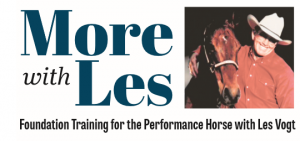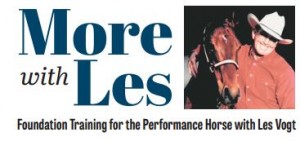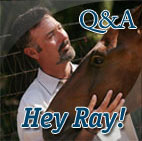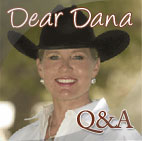Backing: From rein cue to active leg cue
41st in a Series
 After Les showed us turns on the forehand last issue, let’s go the opposite direction and back up.
After Les showed us turns on the forehand last issue, let’s go the opposite direction and back up.
Your goal when you back is to not have to pull back hard on the horse’s mouth to get him to move backward, but to be able to use just enough contact with the bit to tell him to not go forward—kind of like shifting him into reverse—and then using your legs, like the gas, to move backward. Yes, you might have to tug a little to get him started, but your goal is to take it from an active rein cue to an active leg cue as quickly as possible.
The timing of your command and correction, if it’s needed, is really important as well. You can’t say “whoa” and correct at the same time. You have to say “whoa,” wait for him to try, and then correct him if he doesn’t stop. In order for the horse to learn, you have to give him a chance to do it right. When he does give you an effort, make sure he knows it was the right one. He just made his first move toward a great sliding stop! Nothing you see in a reining class is done overnight; it’s done through years of consistent training, but the hardest part can be the consistency.
Why hip control is so important
 Having control of the horse’s hips will prove to be quite critical for almost all of your reining maneuvers. You’ll need it for departures, lead changes and turnarounds particularly. Since many of the body control exercises that we’ll be working on in the next level will require you to have some hip control, you need to get started on it early in the program.
Having control of the horse’s hips will prove to be quite critical for almost all of your reining maneuvers. You’ll need it for departures, lead changes and turnarounds particularly. Since many of the body control exercises that we’ll be working on in the next level will require you to have some hip control, you need to get started on it early in the program.
Point to Remember:
On this and most other things, you teach your horse. We’ll never be strong enough to make a horse do anything, but we can be smart enough to make him want to do it, and that’s what riding is all about.
 Last issue, Les demonstrated use of a light brace rein to keep shoulders out of the way. Now, let’s work on turns on the forehand.
Last issue, Les demonstrated use of a light brace rein to keep shoulders out of the way. Now, let’s work on turns on the forehand.
Start by walking along the fence. Pick a point to stop the horse and then make a very light contact with your inside (away from the fence) rein while you reach back with your fence-side leg and push or bump your horse’s hip around. You’re creating energy with your leg to push the hip, and your brace rein contact will lightly block him from pushing through with his shoulder. With the fence in front of him you don’t give your horse any other options but to move his hip. Do this exercise repeatedly (it’s called a turn on the forehand) both directions. Start by just asking for a step at a time and then increase the number of steps as your horse’s responses get more consistent. Remember to keep life in your reins and leg as you ask for this exercise.
Exercise 3: Body control on the fence
39th in a series
Last issue, Les started Exercise 3 with highlights on the brace rein and ribcage control. Now we’ll go to work.
Exercise number three is basically sidepassing, but it will have one big difference for most of you. While most novice riders start sidepassing by moving the shoulders and catching up with the hips, I’m not going to let you do it that way. Letting a horse lead with his shoulders creates such a disaster when it comes to lead changes that we simply never let them lead with their shoulders when we use our leg in the middle, or the back, position. We are always using a light brace rein to keep their shoulders out of the way, or at least neutral.
 Les gave us last issue a primer on developing your horse’s movement. Now we get into the details of Exercises 3 and 4.
Les gave us last issue a primer on developing your horse’s movement. Now we get into the details of Exercises 3 and 4.
The Brace Rein
Remember how you used your rein to move the horse’s shoulders? First making light contact for bend, then lifting your hand and moving over to direct the shoulders? Well the brace rein is the same concept, except rather than using it to move the horse’s shoulders, you’re just asking him to keep them out of the movement by just maintaining a slight bend with his neck. Whenever you are using the brace rein, you want to make sure that your other rein is way away from the horse’s neck.
Muscle memory and your horse’s entire body
37th in a series
 Last issue, Les really dialed us into yielding and bending to either side in a willing, balanced manner. As we head into Exercises 3 and 4 in Les’s program, here’s some items to focus on.
Last issue, Les really dialed us into yielding and bending to either side in a willing, balanced manner. As we head into Exercises 3 and 4 in Les’s program, here’s some items to focus on.
Objective:
• To start teaching your horse to let you move his whole body laterally
• To start teaching your horse to let you move his hip
• To learn to do both of these things without letting the shoulder lead the movement
• To improve your back-up or overcome resistance if you’re having problems
• To learn to feel whether your horse is straight from head to tail and learn how to correct him if he is not
• To learn how to back your horse easily and softly
Reverse Arc: Leading with the shoulder
36th in a series
 Once your horse is moving his shoulders on a diagonal line both ways (without much work or effort on your part or his), we’ll add to the level of difficulty by asking him to actually step around in a circle with his shoulder leading—a movement commonly referred to as the reverse arc.
Once your horse is moving his shoulders on a diagonal line both ways (without much work or effort on your part or his), we’ll add to the level of difficulty by asking him to actually step around in a circle with his shoulder leading—a movement commonly referred to as the reverse arc.
You’ll want to start as you have in the past, however, now you will tighten up the cues even more until you start doing about a 30-foot circle instead of just your diagonal line. At first a quarter circle is fine, then a half, and finally the horse should be able to continue this way as long as you ask him to. One of the great things about this exercise is that as you go around, you are actually teaching the horse to step across with his front legs, just like he will do in the turnaround. Only now, with the reverse arc, you have much more control of his shoulders.
 After an overview last issue on isolation and control of your horse’s shoulders, Les gets into detail in Exercise No. 2.
After an overview last issue on isolation and control of your horse’s shoulders, Les gets into detail in Exercise No. 2.
On our first shoulder exercise, we started in small circles and then moved his shoulder into the opposite direction of your circle, keeping the neck soft with no resistance. Now, let’s go through the sequence of exercise number two, moving the shoulder to the right:
Shoulder control: Departures and lead changes
34th in a series
 After focusing on the head and neck with lateral and vertical flexion, Les takes us now into control of the shoulders.
After focusing on the head and neck with lateral and vertical flexion, Les takes us now into control of the shoulders.
Our objective in these exercises is to learn to isolate and control your horse’s shoulders. As with all these exercises, the effectiveness of your hand and leg cues will continue to improve and get more subtle, and you will learn to guide your horse and change direction by moving only his shoulders.
Although no maneuver is initiated with a shoulder, there are many where it is critical to keep the shoulder out of the way. By learning to control the shoulder, you are learning how to keep it out of the way too. Specific maneuvers that this apply to are departures and lead changes.
Another common problem that requires shoulder control is when a horse tries to “drop a shoulder” or lean into his circles. We’ll cover this in future lessons, but you’ll need shoulder control to fix it. Shoulder control is also a fundamental part of creating pretty “shoulders up” circles and stops.
Maintaining Softness in the Neck
33rd in a series
 Again, the first place that resistance is going to show up is in your horse’s neck. You’re going to ask him to do something, and rather than softly responding he’s going to stiffen his neck and brace against your hand. You simply have got to train yourself to not let this happen. You have to insist that he be soft in the poll at all times. Why will a horse resist? Because he doesn’t like what you’re doing or he doesn’t like what you want him to do. Where did he get these opinions?
Again, the first place that resistance is going to show up is in your horse’s neck. You’re going to ask him to do something, and rather than softly responding he’s going to stiffen his neck and brace against your hand. You simply have got to train yourself to not let this happen. You have to insist that he be soft in the poll at all times. Why will a horse resist? Because he doesn’t like what you’re doing or he doesn’t like what you want him to do. Where did he get these opinions?
First, he could be bracing because at some point you were too quick or harsh with your hands. You want to always to use light pressure, and then lightly bump if you get resistance, giving the horse slack as soon as he yields.



 Read Columns
Read Columns

